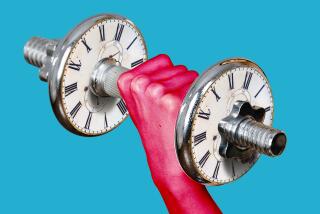The Aging Athlete: Fighting That Uphill Battle
- Share via
At some point in every athletic career, age wears the edge off performance. Natural physiological changes, as well as the wear and tear of years of training, take their toll on the body. Psychological changes also affect an athlete during this time.
Most elite athletes reach a peak level of fitness and skill in their 20s and 30s. Swimmers and gymnasts, who often start training during grade school, may achieve top ranks in their sports as early as their teens. Golf and tennis pros, on the other hand, may reach their highest caliber later in life.
A large number of athletes my partners and I see in our practice feel a conflict between an aging body and their memories of a body at its best. It is a difficult psychological experience. Many athletes--as well as others who exercise--are motivated by ego and a sense of pride in their performances. Fatigue or boredom with training, with workouts and even with competition can decrease that drive, which in turn may lead to depression.
Ego Trap
According to Bryant Cratty, Ed.D., author of “Psychology in Contemporary Sport” (Prentice Hall, Englewood Cliffs, N.J., 1983), athletes in high-endurance sports that require heavy training are most susceptible to psychological effects such as depression or anxiety when they stop competing. Athletics have become an integral part of their self-concepts and ego-support mechanisms. In some cases, an athletic identity may have masked symptoms of other psychological problems.
Cratty recommends that elite athletes avoid a sudden stop in training and taper off gradually while continuing an exercise program. He points out that various sports have master’s programs that allow older athletes continued visibility, training and competition.
In our practice, we often recommend counseling during this time. An athlete can find support in therapy with a sports psychologist or in talking to a friend who has gone through similar changes.
Athletes should also seek professional advice while adjusting to physiological changes. The first step is to review how the body ages, then make the necessary changes in the training program.
Different physical demands will also affect an athlete’s metabolism. During training and competition, an athlete’s daily calorie needs range from 3,000 to as high as 8,000. When the training program changes, calorie intake must decrease as well. It is important to determine what type of exercise program and modified diet will best maintain fitness and health.
In most cases, the first signs of aging are overuse syndromes. We commonly see chronic tendinitis, cartilage fragments in joints, worn cartilage, such as chondromalacia of the knee, and frayed Achilles’ tendons. These effects of age--simple wear and tear on the body--are reversible. In other words, if you stop or vary the activity, a healing process begins.
Competitive athletes can benefit from changing their focus from a single sport to a more varied program. We always recommend aerobic exercise for continued cardiovascular and weight control benefits. Cardiovascular conditioning is the key to overall health. This applies even to athletes who formerly competed in non-aerobic sports, such as the discus throw or shot put, volleyball or baseball.
Many professional athletes must learn new sports when they switch from competition to fitness training. Athletes suffering overuse injuries can also benefit from a low-impact activity like cycling or swimming.
The second stage in physical aging usually starts in the late 50s or early 60s. These normal physiological changes are not reversible; most are rooted in an athlete’s genetic makeup.
The loss of elasticity in body tissues is probably the foremost problem for the aging athlete. All of us notice wrinkles and sagging skin; the same process affects tendons and ligaments. For the athlete, these changes mean a loss of strength and stamina. In addition, the chances of injury increase. Younger tendons stretch or tear and heal, but 60-year-old tendons might snap.
In general, injuries don’t heal as well after age 50. We recommend that older players choose non-contact sports and avoid rough sports, such as soccer, where they would be more prone to injury.
Loss of bone density also affects an athlete’s resilience, and orthopedic problems such as arthritis occur more frequently after age 60. Bone loss is more rapid in women and accelerates after menopause, though preventive measures may defer or lessen bone loss later in life. But the aging skeleton may be more vulnerable to breaks or stress factures from repetitive activity, such as running.
Ken Cooper, a doctor who is president and founder of The Aerobics Center in Dallas, Tex., works with many competitive athletes who are making the transition from what he describes as advanced- to mature-level training. He says athletes can modify their programs and maintain high fitness levels without risking injury. Cooper, a former marathoner, has been running for 28 years.
“I’m convinced that if I had continued with my aggressive 60- to 80-mile-a-week training program and competition, I probably would have gone the route that I’ve seen several of my patients reach. They can’t do anything now,” he said. “But since I’ve made that transition, I’ve been able to continue running almost completely symptom-free.”
Cooper, now 57, stopped competing in 1969. About 60% of his patients older than 40 have reached a mature stage of training, cutting back in speed and distance running. They derive similar physiological and psychological benefits from their modified routines, without straining their bodies.
“The important thing is, you can’t store fitness,” Cooper said. “I want to keep people running and exercising for the rest of their lives.”


